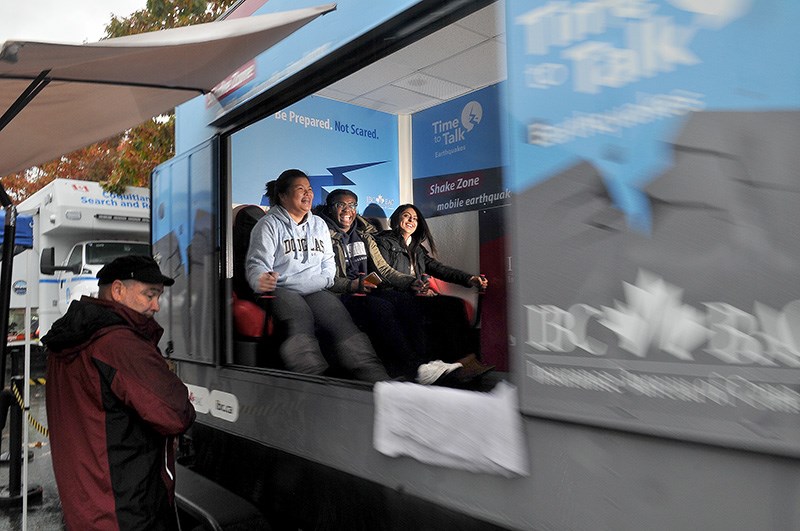I survived an 8.0 earthquake.
So did dozens of other people who braved Wednesday’s monsoon to check out a display in the parking lot at Pinetree community centre of Coquitlam’s emergency services that would be deployed after an earthquake disaster.
The event included booths from the Red Cross, St. John Ambulance, Coquitlam Search and Rescue, and Coquitlam Fire and Rescue service that demonstrated how they would extricate a victim from a vehicle crushed under a collapsed overpass.
But it was the Insurance Bureau of Canada’s ShakeZone simulator that had people lining up in the downpour — after all, natural disasters (even simulated ones) don’t wait for sunny days.
The simulator is a mocked-up living room in a trailer mounted on springs. When the operator activates a mechanical arm, the room sways back and forth, up and down, accompanied by a low, gut-churning rumble, like a 1970s disaster movie meets a midway ride at the PNE. The motion can last anywhere from 40 seconds to up to five minutes — much like an actual 8.0 earthquake, said Aaron Sutherland, vice-president for the Pacific region of the Insurance Bureau of Canada.
Sutherland said the simulator helps take a major earthquake from an abstract idea to reality. We’ve been hearing doom-and-gloom stories about the anticipated Big One for years but, until it happens, we tend to live in denial. By then, though, it will be too late.
“Sometimes, to really get serious about it, you have to go through it,” Sutherland said.
While the trailer is sparsely furnished with an old iMac computer, an inkjet printer and, curiously, a couple of large beakers containing coloured water, and the three theatre-style seats are equipped with steadying hand grips, the idea, Sutherland said, is to get people thinking about the surroundings in their home, the things that could fly off countertops, fall off walls, tip over and tumble.
“People can take that home and realize what steps they need to do,” Sutherland said of the rattling ride.
Greg Kanya, Coquitlam’s manager of emergency programs, said Wednesday’s event was all about educating people about the resources that will be available should a real earthquake strike even though it might take a while for those resources to reach them.
“Our message is to be prepared to survive on your own for up to 72 hours, but be prepared to wait for up to a week,” Kanya said.
And that “culture of preparedness” will only happen when we realize a major quake is inevitable, Sutherland said.
“We know the science, an earthquake will come.”



